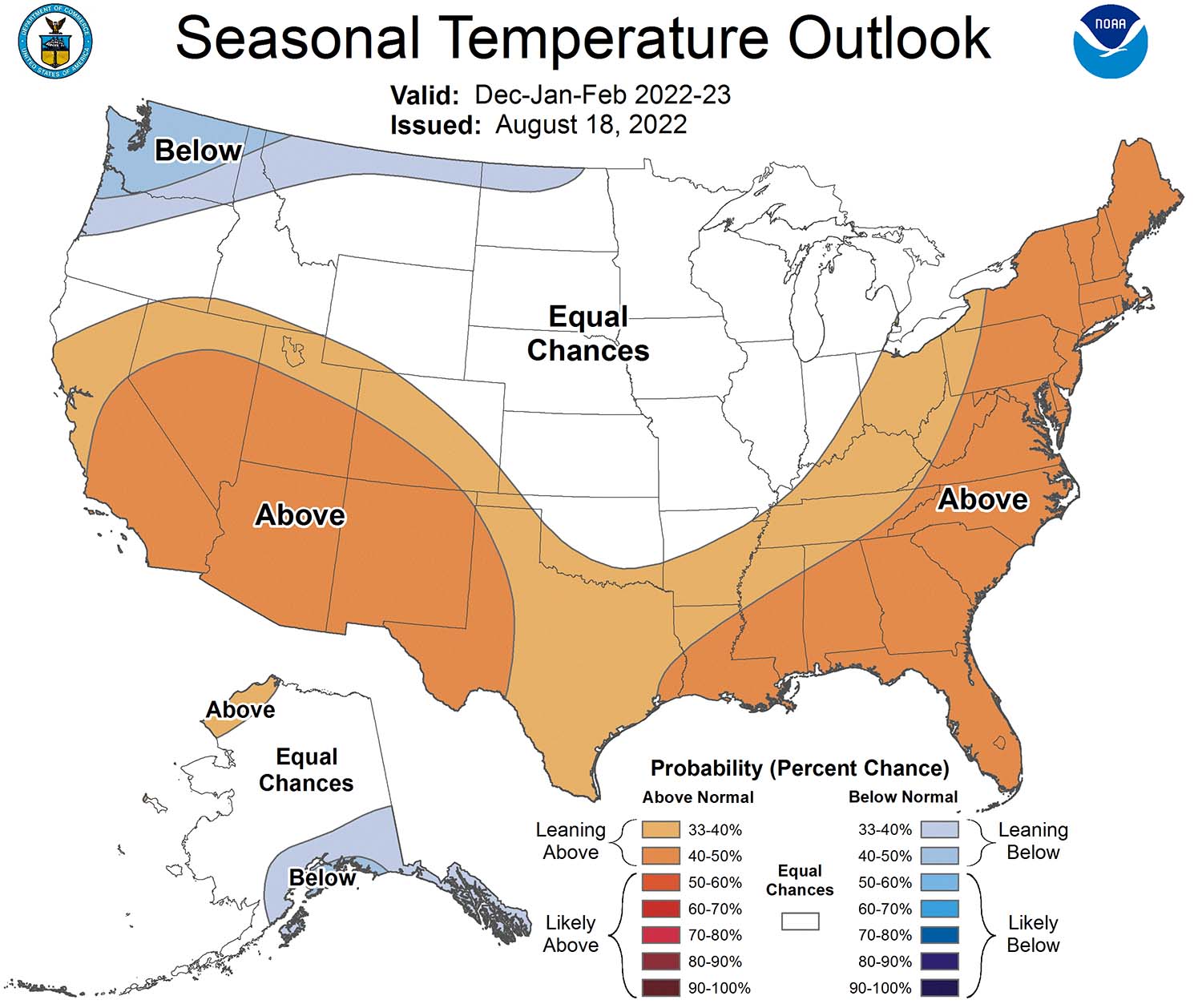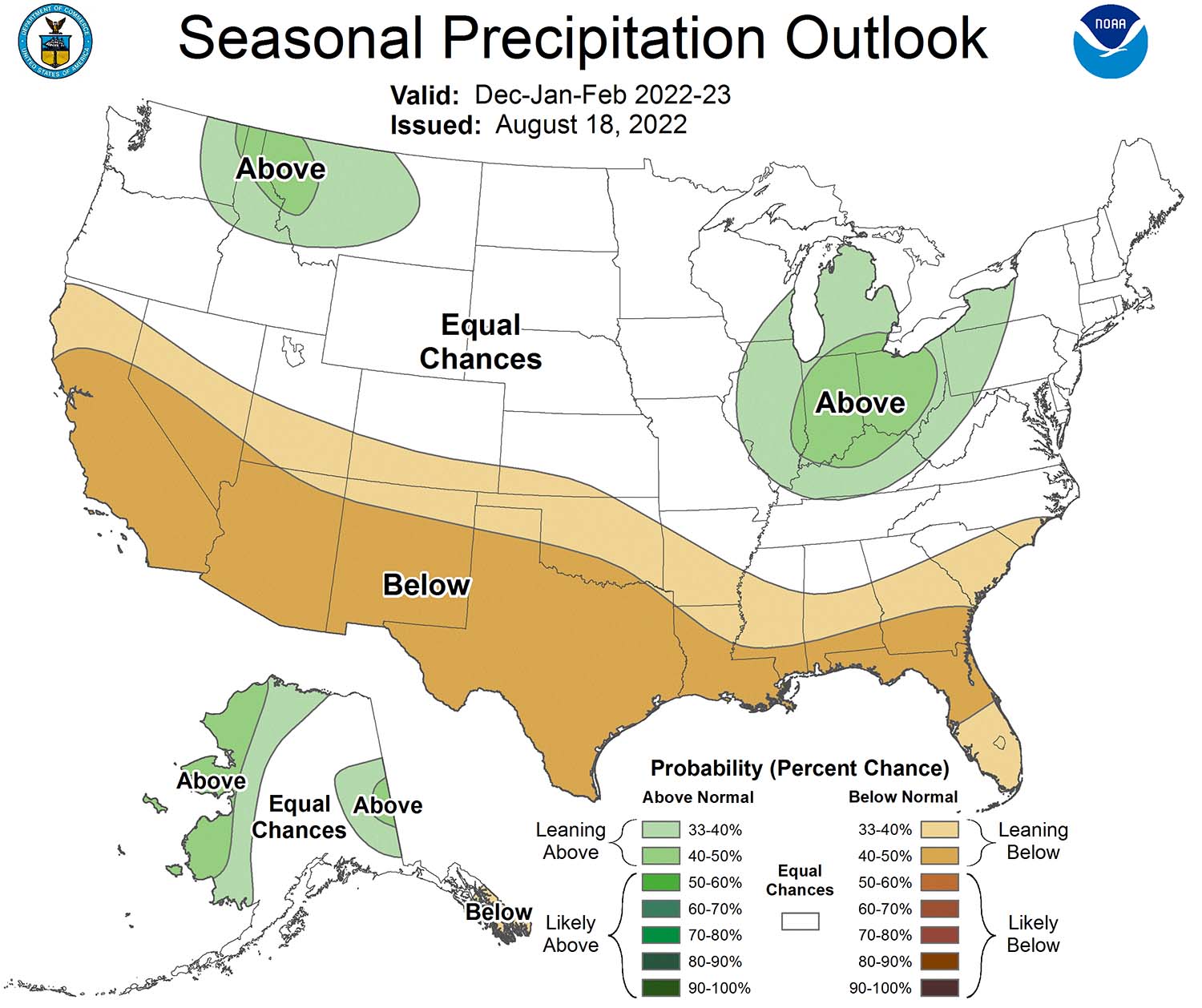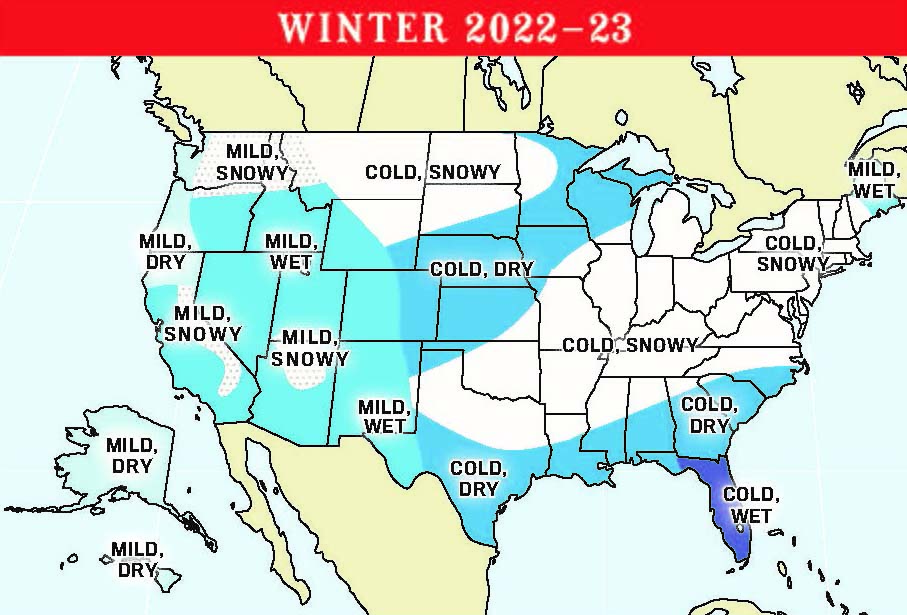Originally posted on 9/14/22, this article was named one of The ACHR NEWS' top 5 articles for 2022.
This year’s winter weather predictions vary from expert to expert and are subject to change as the season draws closer. But contractors can still prepare for whatever’s to come.
Paul Pastelok, senior meteorologist and lead U.S. long-range forecaster at AccuWeather, said that this year has been one of the most difficult forecasts he’s put together in years.
Peter Goble, climatologist and water availability specialist at Colorado Climate Center at Colorado State University, interpreted the latest outlook from the National Weather Service (NOAA) Climate Prediction Center.

Click map to enlarge
TEMPERATURE: Winter weather temperature patterns expected to occur during this year’s predicted La Niña. (Courtesy of the National Oceanic and Atmospheric Administration (NOAA). )

Click map to enlarge
PRECIPITATION: Winter weather precipitation patterns expected to occur during this year’s predicted La Niña. (Courtesy of the National Oceanic and Atmospheric Administration (NOAA). )
Pastelok and Goble both said that a third year of La Niña is likely, which usually means less cold early to mid-winter in the east. However, Sarah Perreault, senior editor of The Old Farmer’s Almanac, said this winter it looks like a neutral to weak El Niño — which means most of the country is going to be colder than normal.

Click map to enlarge
COLDER WEATHER: The Old Farmer’s Almanac weather map indicates huge differences in winter weather for both sides of the country. (Courtesy of the Old Farmer’s Almanac)
What does this mean for HVAC contractors? It could go either way.
“We kind of expect the worst of it to be in areas that are generally used to the cold and are prepared for it. That doesn’t mean they shouldn’t be ready for [abnormal weather] to hit,” Goble said.
Perreault said that the predicted El Niño informs HVAC contractors that people aren’t going to be needing their a/c; they’re going to be needing their heat.
Northeast
Sea surface temperatures over the Atlantic forecast a warmer winter, Goble said.
However, Perreault at The Old Farmer’s Almanac said all of the Northeast region, besides the very tip of Maine, is forecasted to have below normal temperatures. The coldest periods will be in early and late January, and then again in February. The Northeast region can expect above average snowfall, with the most significant snow storms in early to mid-January.
Atlantic Corridor
Perreault predicts temperatures will be below normal, with above normal precipitation and snowfall. The coldest temperatures in this region will be in early and late January and most of February. The most significant snowstorm is expected at the end of January.
On the other hand, Goble said a warmer, milder start to winter is predicted. In November, there’s some “funky” stuff that could bring in some brief early cold snaps, he said, but the temperature should average above normal.
Appalachians
Temperatures are forecasted to be below normal, but snowfall will be above normal. Its coldest period will be in late January and mid to late February. A steady stream of snow showers is expected in early January and then again in late January, Perreault said.
Southeast
Both temperatures and precipitation are forecast to be below normal, Perreault said. Snowfall in this region will be above normal in the east and below normal in the west. The snowiest periods in this region will occur in early and late January and then again in mid-February.
Florida
Florida will experience a colder than normal winter with cold spells in early and late January, Perreault said, and then again in mid-February. February is forecast to be the rainiest month of the winter.
Lower Lakes
Temperatures are forecast to be below normal, with coldest periods in late January to mid-February. Both precipitation and snowfall will be above normal with periods of heavy snow in mid to late January, Perreault said.
Goble of Colorado Climate Center said that due to the forecasted La Niña winter, there will be a wet spot in this region.
Ohio Valley
Perreault predicts temperatures and precipitation to be below normal, and snowfall is forecast to be above normal. The coldest periods will be in early and late January and much of February. Snow periods will occur through January into late February and early March.
Goble said an increased chance of above normal precipitation is forecasted.
Deep South
Temperatures are forecast to be below normal, with below normal precipitation and above normal snowfall in the north, Perreault said. The likeliest chances for snow in the north will be in early to mid-January and then again in mid-February.
Upper Midwest
According to Perreault, temperatures are forecast to be below normal with its coldest periods scattered throughout January and then again in mid-February. Precipitation and snowfall will be below normal in the east and above normal in the western parts of the region. Heavy snowfalls begin as early as November and in early December.
Pastelok said things are a little fuzzy when looking at the Midwest in terms of temperature. AccuWeather can’t pin point confidently enough just yet if it’ll be a below normal winter, or back and forth enough between below and above where it averages out to being pretty normal.
Goble said an increased chance of above normal precipitation, and definitely snow. There’ll be some good winter storms here.
Heartland
Temperatures are forecast to be below normal, Perreault said, with the coldest periods in early to mid-January and mid to late February. Precipitation and snowfall will be above normal in the east and below normal in the west. Snowfall begins as early as November and snow weather is expected in early to mid-January and throughout February.
Goble said an increased chance of above normal precipitation, and an elevated probability to have milder than normal temperatures and below normal precipitation in Mississippi.
Texas-Oklahoma
Goble said there’s an elevated probability of a somewhat mild winter. But, keeping in mind Texas’ winters the past few years, a cold outbreak shouldn’t be ruled out. There’s currently an elevated probability of below normal precipitation.
However, Perreault said temperatures are forecast to be below normal, with the coldest periods in early to mid-January and in early to mid-February. Precipitation will be below normal and in the northern part of the regions, snowfall is forecast to be above normal, with the snowiest chances in mid to late January and early February.
High Plains
Right now, climate models are showing more or less equal chances of above and below temperatures for this region, Goble said — but there will be big cold snaps either way.
Perreault said that temperature is forecast to be below normal, with the coldest periods beginning as early as November into early December, and in early and late January and February. Precipitation and snowfall will be above normal in the north and below normal in the south.
Pastelok of AccuWeather said the forecast is trending toward a mild winter in the first half of the winter, and a colder half in the second half of winter — resulting in a below-normal winter for the northern Rockies.
Intermountain
Temperatures will be above normal, Perreault said, though some cold spells are expected in mid-November and early February. Precipitation is forecast to be above normal with above normal snowfall in the far north and south, with snowiest periods in mid-to-late December and mid-January.
Desert Southwest
At this point, above normal temperature is predicted, said Pastelok. The region hasn’t yet recovered from last season’s abrupt end to snow and rain due to wildfire season, so above normal, dry temperatures are likely. North of Salt Lake City has a chance of snow.
Perreault agreed that temperatures will be above normal, adding that precipitation will be above normal as well. The coldest periods are in mid and late December and then again in mid-January. In the areas of that region that receive snow, the forecast is below normal amounts in early to mid-January and early February.
Pacific Northwest
Temperatures will be above normal with slightly below normal precipitation and snowfall, Perreault said. The cold arrives in November and in early and late December. Snow will arrive in November in the area that receives snow.
Goble said that in this region, there is an increased chance for below normal temperatures, and a slight tilt towards above normal precipitation.
Pacific Southwest
Another mild winter is expected this year, Goble said. There is an increased chance of above-normal temperatures for the winter season and an increased chance of below-normal precipitation.
Perreault said that temperature, mountain snow, and precipitation is forecast to be above normal. Cold temperatures will pop up in mid-November, mid-January, and early February.



Report Abusive Comment